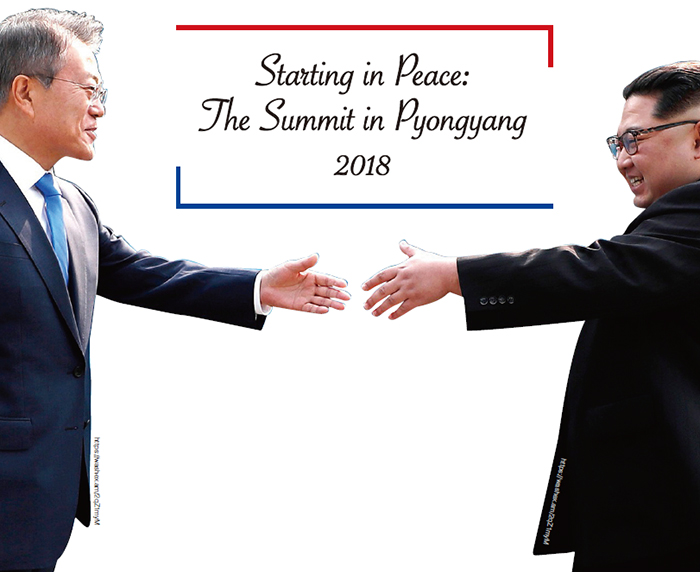
The North-South Summit in Pyongyang was a big issue all around whole world and especially in Korea. Korea is the only divided country in the world and still has military conflicts. Even though North Korea is the closest country to South Korea, South Koreans cannot visit the North. Furthermore, some issues about peace between South Korea and North Korea and denuclearization are important for Northeast Asia and international relations in general. In particular, denuclearization has been discussed since before the Kim Jong-un regime, and the U.S., China, Russia, and Japan have observed the current circumstances with North Korea.
If it continues to possess nuclear weapons, this will bring tensions and anxiety. This is because North Korea has nuclear missiles that can potentially reach to the mainland of the U.S. This implies that several countries allied to the U.S. can be attacked and damaged by a nuclear attack from the North. This is one reason why many countries focus on the nuclearization of the Korean Peninsula. The summit was held in Pyongyang, the capital of North Korea, where South Koreans are not able to visit. Before the third summit was held in Pyongyang, there were two more in 2000 and 2007. In response to these events, The UOS Times will cover the preparation of the summit, which includes several photographs of Pyongyang.
Preparation for the inter-Korean Summit
Before the third inter-Korean summit, the North and South already had two conferences and several high-level talks.
The first inter-Korean summit between Moon jae-in and Kim Jong-un was held on April 27, 2018 at the House of Peace in Panmunjom. The South Korean government has confirmed the official name as the “Inter-Korean summit of 2018.” Before completing the first summit, there were some trials and errors. Although President Moon continued to express his eagerness to talk after being elected, the North was not cooperative. They even tried to heighten tensions in Korea by firing ballistic missiles. Despite these circumstances, Moon suggested that North Korea should participate in the PyeongChang Winter Olympics and announced the Berlin Plan. However, North Korea continued provocations and carried out its sixth nuclear test, and the relationship between North Korea and the U.S. worsened. However, on Jan. 1 of this year, Kim Jong-un announced some dramatic changes in relations between the North and South. He unveiled blueprints to improve inter-Korean relations through constant communication. In response to this announcement, the Minister of Unification proposed holding high-level inter-Korean talks the next day. Finally, a meeting was held at Panmunjom a week after the proposed announcement. After this conference, North Korea constantly communicated with the South, modifying their hostile attitude. The two sides had talks and sent envoys to each other, eventually reaching an agreement to hold a summit in April.
Berlin Plan : In July 2017, President Moon announced his policy on North Korea. He presented a dismantlement of the Cold War structure on the Korean Peninsula and a blueprint for peace. He also proposed that the North resume inter-Korean dialogue, allow separated families to meet on Mt. Geumgang, and participate in the PyeongChang Winter Olympics. He emphasized non-political exchange between the two nations, making it clear that they will pursue denuclearization and peace on the Korean Peninsula.
The Panmunjom Declaration in April was very meaningful in that it confirmed a common goal of “full denuclearization to achieve a nuclear-free Korean Peninsula.” In this declaration, the summit between the North and South promised improvement of North-South relations, a relaxation of military tensions, mutual non-aggression, and a permanent regime of peace, which includes the complete denuclearization of the Korean Peninsula. Through this declaration, the North and South established a foundation for the sustainable development of inter-Korean relations and opened the beginning of a new era of peace on the Korean Peninsula. The two Koreas also confirmed to the world their status and role as parties directly concerned about the problem on the Korean Peninsula. After this statement, an event involving the reunion of separated families was held, and both sides removed the loudspeakers by which they propagate their ideology. In addition, the North agreed to remove their nuclear test sites and promised to open them up to the international community. It also changed its time zone to match the South’s.

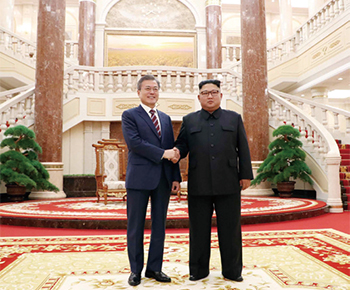
The Second Inter-Korean Summit was held on May 26, 2018 at the Thongil Gak in Panmunjom. At the first Inter-Korean summit, the leaders of the North and South agreed to meet at any time or place in order to discuss matters of mutual importance. On the afternoon of May 25, Chairman Kim Jong Un requested a meeting with President Moon Jae-in, and President Moon willingly agreed. This summit was evaluated as more special than former summits between the North and South because it was achieved as prompt as possible though only an oral agreement. This summit was also significant because the talks have usually been conducted in chaotic situations where tensions between North Korea and the U.S. remained over whether to hold a summit or not. In this summit, the leaders of the two Koreas agreed to cooperate closely for a summit between U.S. and North Korea, which subsequently occurred in June. They reaffirmed their desire for the swift implementation of the first Panmunjom Declaration, and in addition, Kim once again affirmed his commitment to denuclearization on the Korean Peninsula. He also expressed his desire to make the North Korea-U.S. summit successful by moving beyond the days of division and conflict and cooperating to create peace and prosperity. Meanwhile, this conference was crucial for relations between the North and South was a practical step and cornerstone for future summits to be regular and frequent.
Since the Panmunjom declaration, the two countries have been actively interacting with each other. There have been several high-level talks that have addressed various fields. Among these, the fourth high-level talks on August 13 were closely related to the third inter-Korean summit. At the first inter-Korean summit, the two Koreas agreed to hold a summit in the fall. However, the specific subject matter was not decided. Therefore, details were discussed at the high-level talks, and consequently they agreed to hold a summit in Pyongyang in September. In addition, President Moon proposed that a special envoy be sent on September 5. North Korea accepted this proposal, and on September 5, a special envoy to the North visited Pyongyang. The delegation of a special envoy had the same purpose as those from the previous March. This implies that the South Korean government focused on achieving effective goals and maintaining a continuity of talks with the North during the visit. As a result, the two Koreas agreed to hold a summit from September 18 to 20.
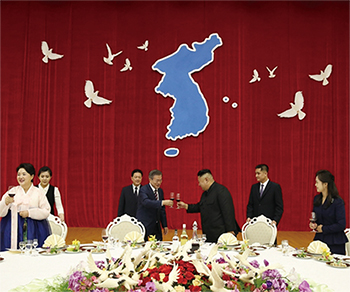

The Inter-Korean Summit in Pyongyang
Pyongyang is the capital and largest city in North Korea. It is called the “capital of the revolution” in North Korea. It was also the capital of Gojoseon and Goguryeo, and it has a long history. Therefore, many historic sites of that period remain in the city. Furthermore, Pyongyang is the richest city in North Korea, and only the privileged can live there, which is why ordinary citizens need passports to go there.
President Moon Jae-in and first lady Kim Jung-sook visited Pyongyang for three days starting on September 18. They arrived at the Sun-an Airport on the morning of the first day and moved to the Baekhwawon guesthouse after an official welcoming ceremony at the airport. At around 3:45 p.m., a meeting was held at the headquarters of the central committee of the Workers’ Party in Pyongyang. The central committee of the Workers’ Party plays a central role in party policies to establish a solid ideological system and organize and guide implementations of the Worker Party’s agreement. For the South, Jung Ui-yong, the Blue House Chief of National Security, and Seo Hun, the Chief of the National Intelligence Service, attended the meeting. For the North, Kim Young-cheol, the Vice Chairman of the Workers’ Party Central Committee, and Kim Yeo-jung, the First Deputy Chief of the Workers’ Party Central Committee, attended the meeting.
The meeting was 30 minutes behind schedule, and after it was over, the President and first lady went to Pyongyang University, also known as Kim Il-sung University, the best university in North Korea. Here, they enjoyed the performances of the Samjiyeon Orchestra. The word “Samjiyeon” is a regional name from Yanggang-do, and it means “three lakes.” Mt. Baekdu, the highest mountain on the Korean Peninsula, is in Samjiyeon. After watching the orchestral performances, a welcome dinner was held at the Mokrangwan, which is a large-scale banquet hall for state guests. Welcoming dinners were served there during the summits in 2000 and 2007. South Korean singers ALi, Ailee, and Zico performed, and the composer Kim Hyung-seok and magician Choi Hyun-woo also performed. These events gave the summit an element of cultural exchange.
On the morning of the second day, a meeting was held at the State Guesthouse in Baekhwawon, where President Moon Jae-in stayed, and the two Koreas signed the Pyongyang joint declaration. The declaration includes not only the elimination of war hazards on the Korean Peninsula, but also a balanced development of the bi-national economy, such as the re-creation of a Mt. Geumgang tour, the re-establishment of the Gaesong industrial complex, and the linking of railways. They also discussed the issue of separated families and cultural exchange and decided to cooperate by co-bidding to host the 2032 Summer Olympic Games together.
However, above all, the denuclearization of the Korean Peninsula was the main point, and North Korea’s missile test sites and the permanent disposal of its launch pads were discussed. Leader Kim Jong-un also said that he would visit Seoul the next time they meet. The results of the meeting were broadcast live and there was also a press conference. After signing the agreement, President Moon held a press conference with Leader Kim and had lunch at Okuryukan in Pyongyang. After that, he held a commemorative planting ceremony at the State Guesthouse with Vice Chairman Choi Ryong-hae of the Labor Party and visited the Man-su-dae creation company to see works of art. After visiting company, President Moon watched a group performance at the largest sports complex in North Korea, Neungra-do 5.1 Stadium. He also made the first speech to North Koreans by a South Korean President in history. In his speech, he said, “We lived together for 5,000 years and have been separated for 70 years” and emphasized the creation of a new future for South Korea and North Korea together.
On the last day of the summit, President Moon, his the first lady, North Korea’s leader Kim, and his first lady all climbed Mt. Baekdu together. The mountain lies on the border between North Korea and China. It is a volcanic mountain, and its name means “white-headed mountain.” This is the coldest place on the Korean Peninsula. It is home to one of the highest crater lakes in the world, called Heaven Lake, which lies at the top of the mountain. It is usually hard to see Heaven Lake clearly, but the weather that day was good, so President Moon and Leader Kim walked around the lake. Kim Jong-sook, the first lady of South Korea, brought a bottle of Baengnokdam Crater Lake’s water. She spilled half of it and replaced it with water from Heaven Lake. This was a symbolic action that symbolized peace on the Korean Peninsula. President Moon also told Leader Kim he would invite him to Mt. Halla on Jeju island the next time they met.
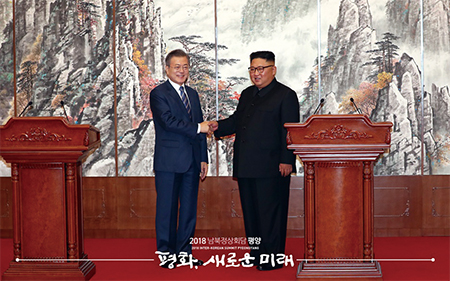

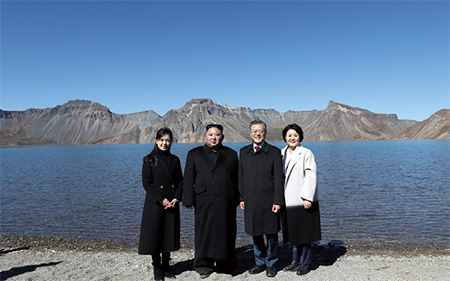
Results of the summit.
As a result of the talks, the two Koreas agreed on five major issues. First, they promised to extend the end of military hostilities in confrontation areas, such as the Demilitarized Zone. They will actively take practical steps to make the Korean Peninsula a permanent peace zone. Second, they decided to seek practical measures to further increase exchanges and cooperation on the basis of mutual benefit and public interest and to develop their national economies in a balanced manner. They agreed to cooperate in various fields such as railroads, tourism, economics, environmental issues, and medical services. Third, the two Koreas determined to further strengthen their humanitarian cooperation to fundamentally resolve the issue of separated families. To that end, they decided to restore and open the facilities of the reunion center as soon as possible. Fourth, they agreed to actively promote cooperation and exchanges in various fields in order to enhance the mood of reconciliation and unity and to show the spirit of the Korean people at home and abroad. The two Koreas will pursue joint participation in international games and exchanges in cultural and artistic fields, and they agreed to work together to win the bid to co-host the 2032 Summer Olympics. Finally, they once again confirmed their commitment to denuclearizing the Korean Peninsula and agreed on specific plans to achieve this. North Korea decided to permanently dispose of its engine test site and missile launcher in Dongchang-ri, under observation by experts from related countries. In addition, Kim Jong-un decided to visit Seoul soon, after being invited by President Moon.
This summit was very meaningful because the hostile military atmosphere on the Korean Peninsula drastically changed, and the two Koreas agreed to prevent accidental clashes and establish military trust through military control. The two countries also agreed on the continued expansion and development of inter-Korean relations based on the implementation of the Panmunjom declaration, which can lead to the full-fledged promotion of peace and prosperity on the Korean Peninsula. Moreover, the two leaders of each nation have been able to further strengthen their trust by holding long-term frank discussions through official talks and various social events. Finally, the fact that a special mission group representing various sectors (such as politics, culture, economics, and civil society) visited the North together laid the groundwork for national consensus and vitalization of inter-Korean relations.
The significance of this summit was so great that many foreign countries paid attention to the meeting and quickly responded once it was over. U.S. President Donald Trump posted “very exciting!” on Twitter right after the summit. He also posted another tweet that quoted a Fox News article that said, “North Korea has again mentioned denuclearization. We have made a lot of progress.” And in a meeting with reporters at the White House, he praised the summit, saying “North Korea made great progress.” President Trump called the September agreement of the Pyongyang Joint Declaration “very good news.” The U.S. State Department also made similar comments. Secretary of State Mike Pompeo welcomed the results of the third inter-Korean summit and said he was ready to begin negotiations to change relations with North Korea immediately. However, some American mainstream media outlets, such as the New York Times and Wall Street Journal, questioned whether the outcome of the summit could trigger substantive denuclearization negotiations.

They suggested that Kim’s suggestion of disposing the engine test site and missile launcher failed to show sincerity over denuclearization. Those criticisms aside, another major country, China, also reacted positively. “We welcome this summit and appreciate the positive efforts of both sides,” a Chinese government official said in a Foreign Ministry regular briefing. The spokesperson also said, “China will also play an active role in resolving the political issues on the Korean Peninsula and realizing the region’s permanent peace.” Meanwhile, in response to the agreement, the Japanese government said, “Japan pays respects to the efforts made by the two Korean leaders to reach the agreement.” However, the Japanese government gave an ambiguous response about questions regarding a North Korea-Japan summit. The country avoided direct answers, simply saying “Japan is receiving various information.” A spokesman for Russia said, “We certainly support such practical and efficient actions on the Korean Peninsula.” The United Nations (UN) also welcomed this communication. “The South and North Korea, each, have prepared to discuss peace and cooperation. We hope that this communication between the South and North will lessen military conflict and achieve denuclearization,” said Antonio Guterres, the UN Secretary General, during a welcoming announcement.

After President Moon visited Pyongyang, two more future summits were scheduled to sustain the amicable relations between the North and South. In November, the South Korean Government prepared for the fourth summit conference in Seoul. During the Pyongyang Summit, Kim Jong-un promised to visit Seoul. If Kim comes to Seoul, he will be the first leader from North Korea to visit the South. Because of this, the communication between the South and North has been quite different from the first and second summits in 2000 and 2007. After the summits in 2000 and 2007, communications between the North and South did not progress at all. Beyond the summit, The UOS Times hopes South Korea and North Korea will continue their cooperative gestures and expects that the things discussed during the summit will be fulfilled. More broadly, this event also affects the situation in North-East Asia generally, and The UOS Times hopes for the North and South to sustain mutual communications and avoid the danger of confrontations and war.
Yi Se-won
devel0ppe@uos.ac.kr
Choi Hyun-jung
guswjd5891@uos.ac.kr

